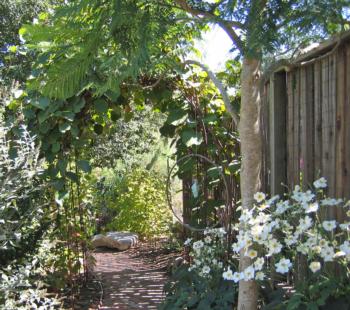Unused stories
Growing In Your Garden Now - Kiwis

As its botanical name implies, kiwis are delicious. Native to China, Actinidia deliciosa is healthy, tasty, and not that hard to grow so long as you have the space and don’t mind its high-water requirement. Here’s what you need to know to be a successful kiwi grower.
Description – Kiwis are hefty, woody, twining vines that can grow 10 feet wide and 20 feet long - or larger if left unpruned. Foliage is round, large, leathery and deep green. Flowers are cream-colored and demure, and emit a mild fragrance. Kiwis are dioecious, meaning they bear either male or female flowers. Consequently, you need one of each sex to produce fruit.
Culture and maintenance – Kiwis prefer full sun but can take part shade. They are purported to do well in California regions where citrus, peaches, and almonds are successful. They need a sturdy trellis, arbor, or other permanent place to climb. They prefer somewhat acidic, well-drained soil that’s rich in organic matter, and they appreciate a citrus (nitrogen) fertilizer in early spring and then again in early summer. Kiwis like water – and lots of it. Keep them well-watered during the growing and fruiting season, especially during heat or wind spells. Keep the mulch thick and plentiful, but avoid having it touch the crown as they can be susceptible to crown rot. Prune in winter. There are no significant pest or disease issues, although cats may enjoy rubbing up against their subtle catnip-like fragrance. Deer munching on leaves and gophers munching on roots will likely be more worthy opponents. Depending on the variety, harvest occurs in November. Fruit can be stored for months in the refrigerator and then ripened in a plastic bag for a couple days on the kitchen counter.
Design considerations – Kiwis are often overlooked as suitable patio and arbor covers. Their large leaves provide welcomed shade in summertime, and the twisting and twining branches offer grape vine-like interest in winter.
Cultivars – Common male kiwis include ‘Matua’, ‘Tomuri’, and ‘Chico’. For females, it’s hard to beat the ‘New Zealand Hayward’, which is the one you see stacked up at the grocery store. It does require a fair amount of winter chill, however, so if you live in coastal regions this may be iffy. For low chill areas, consider ‘Elmwod’, ‘Dexter’, ‘Abbott’, ‘Tewi’, and ‘Vincent’. Other New Zealand cultivars include ‘Allison’, ‘Bruno’, ‘Gracie’, and ‘Monty’. Actinidia chinensis has also become available. These are fuzz-free, with either yellow or green fruit inside. They, too, are tasty and are becoming more common alternatives. Care and maintenance is the same.
By Marie Narlock
